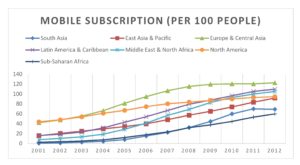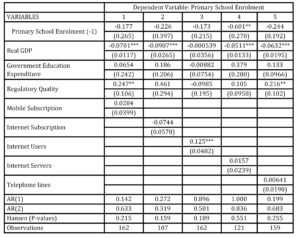Introduction
A simple definition of capital is wealth used to create more wealth. Human capital, therefore, can be referred to as a kind of wealth used to create more wealth in an economy. This suggests that human capital is a relevant component for developing an economy. This assertion has been empirically proven in the literature (Jones, 1996; Barro, 2001).
Given that human capital is this relevant, it will be logical to postulate that improving the level of human capital, particularly through education, is vital to achieve economic growth as well as sustainable development. This also has been validated by the literature (Oluwatobi and Ogunrinola, 2011; Jaiyeola, 2015). It, therefore, means that the more education is made accessible and the more avenues are established for its distribution in means that are affordable, the more people will be educated and the more inclusive growth and development will be achieved.
The issue, therefore, is delivering education to as many people as possible in order to achieve development that is inclusive. This is based on the argument that there is a direct correlation between the level of education and the income of an individual. This suggests that people are able to increase their income and welfare as they improve on their human capital through education. We draw from the postulations of Sen (1999) to corroborate this argument. He posited that when people are deprived of what improves their human capabilities, they are deprived of welfare, which results in poverty, inequality and unemployment. It can therefore be asserted that any means that makes education, which is a process of developing human capital, more accessible to more people is an avenue that supports inclusive growth and development. One avenue examined by this study is information and communications technology (ICT).
ICT refers to technologies that enable the distribution and easy accessibility of information as well as communications. It can basically be defined by personal computers, mobile devices, and the Internet. Given the enabling capabilities of ICT, this study postulates that it has a significant role in delivering education to all at lost. In order to achieve education for all, development of relevant education content, its awareness and distribution are vital. Education content is available; and people are aware. However, its distribution is hampered for reasons such as low teacher-to-student ratio as well as high costs of textbooks, transportation, school infrastructure and maintenance. These further add to the rising cost of education. The study posits that ICT has a role to play in mitigating these costs. This is why this study examines the role ICT plays in human capital development.
Evidence from the literature has shown that Sub-Saharan Africa (SSA) is one of the least developed and least innovative regions in the world; yet it currently ranks the second most populous region out of five regions in the world. This, thus, raises concerns as to whether the people that make up the region are assets or liabilities to be bordered about. Statistics show that 63 percent still live in rural areas and the adult literacy rate is still within fifty percent excluding South Africa. These suggest that the human capital capacity of the people may be insufficient to drive economic development in the region. The challenge usually has been that education, which is required to improve the human capital of the populace is expensive and rising. This study therefore examines the role ICT plays in enabling the human capital development process in SSA.
The argument here is that ICT enables the delivery of education in ways that are more affordable and accessible than conventional means. Leveraging on ICT will, therefore, enable more people access education SSA, thus, leading to increase in the level of human capital in the region; and since human capital is a core requirement to achieving inclusive growth, it can be posited that ICT is an enabling factor for achieving sustainable development.
The rest of this paper is segmented as follows: After the introduction is section two, which is an overview of ICT and human capital development in SSA. Section three presents a review of existing literature on the subject of ICT and human capital development. The methodology employed for the study is discussed in section four. Section five presents the results and its discussion while section six concludes the paper with policy implications and recommendations.
Overview of ICT and Human Capital Development in SSA
This section reveals some stylized facts of ICT and its usage in SSA in relation to other regions of the world. The section also discusses the implications of the ICT trends on human capital development in SSA in terms of the degree of enrolment at the primary, secondary and tertiary levels.
The fact about the use of ICT in SSA is that it has been on the increase. Mobile subscription, for instance has increased twenty-four folds. However, when compared to other regions of the world, SSA still lags behind. Figure 1 depicts a picture of the position of SSA as the least most subscribed. This is a clear indication of the need to bridge the technology gap in SSA. It is expected that as mobile subscription increases, the use of mobile technology to deliver services inclusively will also increase, and vice versa. Education can, therefore, be effectively delivered in SSA in a way that is inclusive.
Figure 1: Mobile Subscription (per 100 people)
Source: World Bank 2015
Pakistan and Afghanistan, for instance, have taken advantage of mobile technology to deliver education to children and youths affected by conflicts and crises. Hence, they can equitably deliver education services (Carlson, 2013). These are clear indications of mobile technologies’ benefits of helping to achieve inclusive development. Thus, SSA can benefit from such privilege given the potentials indicated by the rising trend of mobile subscription in the region.
The Internet is another technology that defines ICT. Its advent has opened the door to limitless knowledge and information required to educate as well as improve numeracy and literacy without restrictions. This is done usually at little or no cost. A student can leverage on the Internet to get an answer to a question like a teacher would. This technology has given access to a pool of knowledge that will enable students to be less dependent on their teachers’ knowledge capacity. With its use, students can contact their teachers outside class hours, collaborate with their colleagues, download study materials and learn concepts not taught in the classroom.
SSA has benefited tremendously from this technology. As shown in Figure 2, the percentage of Internet usage in the region is on the increase. This indicates the increasing number of Internet users as well as increase in the level services being delivered through the technology. However, the percentage of Internet users in SSA falls below other regions except South Asia. This reveals the presence of a digital divide.
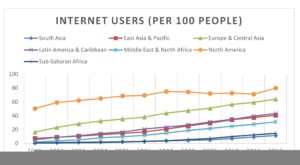
Figure 2: Internet Users (per 100 people)
Source: World Bank 2015
The low percentage of Internet usage may be as a result of the limited Internet infrastructure in the region. Figure 3, which shows the amount of secure Internet servers per a million people, indicates limited level of Internet infrastructure in the region. SSA and South Asia are noted to be the bottom of the chart for the period reported. The flatness of the SSA curve in the diagram also depicts the limited and slow growth in the level of Internet infrastructure. This may limit the level of Internet usage and limit the productivity of the facility given the pressure of increasing Internet usage that will be mounted on the limited Internet infrastructure.
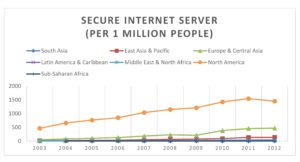
Figure 3: Secure Internet Server (per one million people)
Source: World Bank 2015
Figure 4, which is a trend of the percentage of Internet subscription across the regions of the world, depicts SSA as the region with the least subscription. The subscription growth rate in SSA is also very low as shown by the flatness of the curve. These are indications of inadequate Internet infrastructure in SSA.
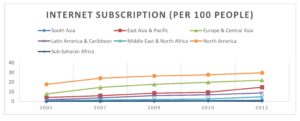
Figure 4: Internet Subscription (per 100 people)
Source: World Bank 2015
Review of Literature
Various studies have been conducted on the subject matter of development, human capital, ICT as well as the relationships that exist amongst them (Jones, 1996; Barro, 2001; OECD, 2005; Oluwatobi and Ogunrinola, 2011; Jaiyeola, 2015). It is also notable to highlight here that the literature provides evidence on the effect ICT has on human capital (World Economic Forum, 2009).
In reviewing this, it is good to note that human capital is an ingredient for achieving inclusive growth and development (Sen, 2013; Asadullah, Savoia, and Mahmud, 2014; Joshi, Hughes, and Sisk, 2015). Sen (1999) also pointed out that wealth is easily distributed and inequality minimized when people’s capabilities are improved through education and health care. With their capabilities improved, they can be instrumental and contributive to the economic development process of a society. This explains the instrumental role of human capital in achieving inclusive growth and development.
ICT is also relevant to achieving inclusive growth and development. This assertion is based on findings from the literature on how ICT enables the delivery of basic and essential services (such as financial services, health care and education) to the bottom billion in ways that are accessible and affordable (Bertot, Jaeger, & Grimes, 2010; Naik, Joshi, & Basavaraj, 2012).
Evidence from the literature also proves that ICT has a role to play in facilitating human capital development (Ilmakunnas and Miyakoshi, 2013; Martin, Ciovica, and Cristescu, 2013; Cheng, Mitomo, Otsuka, and Jeon, 2015).
The potential of ICT in enabling human capital development is reflected in how higher institutions, independent organizations and alliances invest in online and distance learning programmes, massively open online courses (MOOCs), and infrastructure such as smart boards and educational mobile devices (Obiri-Yeboah, Fosu, and Kyere-Djan, 2013; Sanda, Binuyo, and Oduyoye, 2013; Armey and Hosman, 2015).
All these studies validate the fact that a relationship exists between human capital and ICT. However, very few studies have been conducted on this in SSA. More specifically, a study is yet to be identified on how ICT affects the level of school enrolment in SSA. This is the gap this study tries to fill.
Methodology
This study is based on a knowledge economy framework that postulates that ICT is an enabler and the distribution platform for the dispersal of information. It sets the stage for the free flow of information that educates, improves the level of human capital and facilitates school enrolment (Chen and Dahlman, 2005; Kaynak and Arslan, 2012; Asongu, 2013; Jiang, 2014). The model that captures this relationship is as follows:

Where Human_Capital is measured by school enrolment, GDP is measured by real GDP, Govt_Exp is measured by government expenditure on education and ICT is measured by the number of mobile subscriptions, the number of Internet subscriptions, the number of telephone lines and the amount of Internet servers. Data for these were sourced from 2001 to 2012 for 32 SSA countries from the World Development Indicators and the Worldwide Governance Indicators.
This study employed the system generalized method of moments (SGMM) as an estimation technique. The purpose of this choice is to address the likely deficiencies that may arise if endogeneity and heterogeneity problems are not catered for. As postulated by Arellano and Bond (1991), Arellano and Bover (1995) and Blundell and Bond (1998), SGMM is one of the reliable techniques; and its reliability and efficiency is based on its ability to explain idiossyncratic time invariant country effects and cater for endogeneity among the variables.
Results and Discussions
The variables used to capture ICT in this study include the number of mobile subscriptions per 100 people, the number of Internet subscriptions per 100 people, the number of Internet users per 100 people, the number of telephone lines per 100 people and the number of Internet servers per one million people.
This subsection is a presentation of the result of the impact of ICT on primary school enrolment in SSA. Table 5.1 clearly shows the result in five models numbered from 1 to 5. Model 1 validates the importance of income in determining the degree of school enrolment at the primary level as indicated by the statistical significance of Real GDP. However, the coefficient of the variable has a negative sign, thus, indicating that an inverse relationship exists between the variable and primary school enrolment.
This relationship is consistent in all the five models in Table 5.1. This is an indication that the value of economic output in SSA may not be a reason strong enough to encourage school enrolment at the primary level. This is contrary to theoretical expectation. This result could mean that the majority in SSA tend to see increase in economic output as an opportunity for wealth building rather that encouraging basic education. The non-significance of Government Education Expenditure as a percentage of GDP for all the five models buttresses this concern. This result indicates that the portion of GDP the government expends on education hardly affects primary school enrolment.
Model 1 in the table shows the importance of institutions in facilitating primary school enrolment. The result shows that an improvement in Regulatory Quality by 1 percent increases primary school enrolment by 25 percent in SSA. Governments of SSA countries can therefore take advantage of this to regularize the transmission mechanism of how economic output will substantially trickle to affect basic education. Hence, it is not sufficient to make laws that basic education is compulsory as most SSA countries have done. Much more important is the implementation of such laws. This will help to minimize the abnormal use of children (for activities such as trading and trafficking) and in turn increase their attendance in schools to improve on their capabilities and secure their future.
Mobile Subscription, Internet Subscription, Internet Servers and Telephone lines were not statistically significant, thus, indicating that availability and subscription of ICT in SSA have not substantially been instrumental in advancing basic education in SSA. These results also suggest that the availability and the subscription of ICT is not sufficient to enable basic education; it has to be used. This is indicated by the positive relationship between Internet Users and primary school enrolment as shown in model 3 of Table 1. The result shows that an increase in the usage of Internet technology by 1 percent increases primary school enrolment by 13 percent. Thus, ICT can be useful beyond its basic purpose. Policy makers in SSA can therefore promote the usage of ICT for educational purposes as well as the delivery of basic education.
Table 1: Primary School Enrolment and ICT in SSA (SGMM Result)
Standard errors are in parentheses
*** p<0.01, ** p<0.05, * p<0.1
Table 1 is a presentation of the econometric results of examining the relationship between ICT and school enrolment at the secondary level. Model 1 of the table shows the significance of economic output to secondary school enrolment. However, an inverse relationship also exists between the two. This can be an indication that secondary education is yet to be inclusive in SSA and the majority is yet to benefit from it. This is a clear call for sound and qualitative regulations and institutions. The signs of the coefficients of Regulatory Quality are positive for all the models and the variable was statistically significant in models 1, 2 and 5. This buttresses the fact that institutional quality is vital in enabling school enrolment at the secondary level. Quality institutions will discourage misallocation and misappropriation of public funds and help to divert resources to productive sections such as education.
The result clearly shows that ICT is instrumental in secondary education in SSA. For instance, an improvement in mobile subscription increases school enrolment by 59 percent. This is not farfetched given that there is a higher degree of maturity and exposure for children within the secondary school age bracket, when compared to primary school children. Thus, they can engage mobile technology for learning and educational purposes. This will not only improve capabilities but increase the need to enroll in school. Further, ICT can be engaged to deliver secondary education affordable as indicated in the result. This is an indication of the possibility that secondary school students can learn remotely while saving transportation costs. Moreover, secondary schools can save administration costs as well as costs on additional infrastructure via ICT.
Model 2 of Table 2 shows that the use of the Internet advances the level of secondary school enrollment. Thus, as people use the Internet, they get more informed and enlightened. These inform them on the need for education and enrollment to further their studies and those of their children.
Table 2: Secondary School Enrolment and ICT in SSA (SGMM Result)
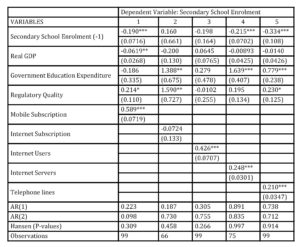
Standard errors are in parentheses
*** p<0.01, ** p<0.05, * p<0.1
Models 3 and 5 of Table 3 reveal that there is a direct relationship between economic output and tertiary school enrolment in the SSA region. This is a clear indication that the level of human capital in an economy advances with the growth of that economy. Thus, education can be made more accessible as the wealth of the economy expands. The concern, however, is the inverse relationship between government education expenditure and tertiary school enrolment as depicted in models 1 and 5 in Table 3. Much more of the concern is the magnitude of the coefficients in models 1 and 5. This suggests that government education expenditure in SSA has a negative impact on tertiary school enrolment in SSA.
This could mean that education at the tertiary level is hardly funded by the government and mostly funded from private pockets in SSA. The inverse relationship between regulatory quality and tertiary school enrolment, as indicated in models 3 and 5 of Table 3, is an indication that there are unfavourable regulations where tertiary school enrolment in SSA is concerned. Thus, there could be regulations that restrict substantive enrolment rate at the tertiary level. The case of Nigeria, for instance, is that the majority of those enrolling into tertiary education institutions may have to write the JAMB entry level examination more than once despite that the examination is conducted once a year.
All the ICT variables in Table 3 are statistically significant and their coefficients have the positive signs. This is a clear indication of the vital role ICT plays in enabling human capital and its development in SSA. An improvement in mobile subscription by 1 percent increases tertiary school enrolment by almost the same degree (0.937). This is a signal that subscribing to mobile technology and the use of mobile phones in SSA are becoming broad channels for educating and transferring information. A significant relationship also exists between Internet subscription and tertiary school enrolment.
This explains the importance of ICT in enabling the delivery of education at the tertiary education level in SSA. Model 3 shows that enrolment at the tertiary education level is enhanced as Internet technology is used. This is an insight into the fact that ICT infrastructure is relevant in promoting access to education in SSA. This is not farfetched given that ICT facilitates the delivery of basic and essential services such as education in ways that are accessible and affordable. Thus, locations in SSA where there are little or no institutes of higher learning, education can easily be delivered to them via ICT. Moreover, those seeking such education to improve their capabilities will save transportation costs required to attend distant physical learning centres. In addition, school proprietors will be able to save costs of addition services responsible for rising costs of education; costs covering elements such as the construction and maintenance of classrooms, administration of units, utilities, to mention a few.
Table 3: Tertiary School Enrolment and ICT in SSA (SGMM Result)
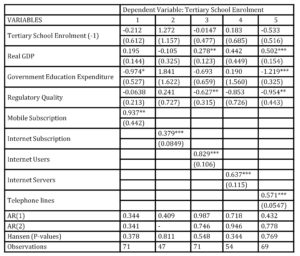
Standard errors are in parentheses
*** p<0.01, ** p<0.05, * p<0.1
Conclusion, Policy Implications and Recommendations
ICT usage in SSA has been on the increase over the years, but when compared with other countries of the world, SSA countries still lag behind. Hence, there is a need to bridge the technology gap that exists in SSA. This is because ICT enables the delivery of education in ways that are more affordable and accessible than the conventional means. Leveraging on ICT will enable more people access education in SSA thereby leading to an increase in the level of human capital in achieving inclusive growth.
Using panel data for 32 SSA countries that span from 2001 to 2012 with the system generalized method of moments (SGMM) technique of estimation, it was discovered that an inverse relationship exists between government expenditure on education and school enrolment, a proxy for human capital. It was also seen that a positive relationship exists between Internet usage and enrolment in primary, secondary and tertiary education. In addition, there is a clear indication that the level of human capital in an economy advances with the growth in that economy and ICT plays a vital role in enabling human capital development in SSA.
Based on these findings, this study recommends that governments in SSA countries should not only make laws that make basic education compulsory, but should also focus on the implementation of such laws. This will minimize the increase of school enrolment, which improves capabilities and helps secure the future. Further, policy makers in SSA should encourage the usage of ICT for educational purposes as well as for the delivery of basic education. This can be done by making available adequate ICT infrastructure, particularly, secure Internet servers. This will increase the level of ICT usage and promote the delivery of services, such as education, via the infrastructure. In addition, policy makers in the region should make available other supporting infrastructure, such as electricity, to enable the usage of ICT and maximize it for the delivery of education.
References
1. Arellano, M., & Bond, S. (1991). Some Tests of Specification for Panel Data: Monte Carlo Evidence and An Application to Employment Equations. Review of Economic Studies, 58(2): 277-297.
Publisher – Google Scholar
2. Arellano, M., & Bover, O. (1995). Another Look at the Instrumental Variable Estimation of Error Components Models. Journal of Econometrics, 68(1): 29-51.
Google Scholar
3. Armey, L. E., & Hosman, L. (2015). The Centrality of Electricity to ICT Use in Low-Income Countries. Telecommunications Policy, doi:10.1016/j.telpol.2015.08.005.
4. Asadullah, N. M., Savoia, A., & Mahmud, W. (2014). Paths to Development: Is there a Bangladesh Surprise? World Development, 62: 138-154.
Publisher – Google Scholar
5. Asongu, S. A. (2013). Modeling the Future of Knowledge Economy: Evidence from SSA and MENA Countries. Munich: MPRA.
Google Scholar
6. Barro, R. J. (2001). Human Capital and Growth. American Economic Review, 91(2): 12-17.
Publisher – Google Scholar
7. Bertot, J. C., Jaeger, P. T., & Grimes, J. M. (2010). Using ICTs to Create a Culture of Transparency: E-government and Social Media as Openness and Anti-Corruption Tools for Societies. Government Information Quarterly, 27(3): 264-271.
Publisher – Google Scholar
8. Blundell, R., & Bond, S. (1998). Initial Conditions and Moment Restrictions in Dynamic Panel Data Models. Journal of Econometrics, 115-143.
Google Scholar
9. Carlson, S. (2013). Using Technology to deliver Educational Services to Children and Youth in Environment affected by crisis and Conflict. USAID.
10. Chen, D., & Dahlman, C. J. (2005). The Knowledge Economy, the KAM Methodology and World Bank Operations. Washinton DC: The World Bank.
Google Scholar
11. Cheng, J. W., Mitomo, H., Otsuka, T., & Jeon, S. Y. (2015). The Effects of ICT and Mass Media in Post-Disaster Recovery: A Two Model Case Study of the Great East Japan Earthquake. Telecommunications Policy, 39(6): 515-532.
Publisher – Google Scholar
12. Ilmakunnas, P., & Miyakoshi, T. (2013). What are the Drivers of TFP in the Aging Economy? Aging Labour and ICT Capital. Journal of Comparative Economics, 41(1): 201-211.
Publisher – Google Scholar
13. Jaiyeola, S. V. (2015). Human Capital Investment and Economic Growth in Nigeria. African Research Review, 9(1): 30-46.
Publisher – Google Scholar
14. Jiang, Y. (2014). Knowledge Economy and Knowledge-Based Development: A Tentative Discussion. In Y. Jiang, Trade, Foreign Direct Investment, and Development Strategies (pp. 205-2010). Chandos.
15. Jones, C. I. (1996). Human Capital, Ideas, and Economic Growth. Carlifornia: Stanford University.
16. Joshi, D. K., Hughes, B. B., & Sisk, T. D. (2015). Improving Governance for the Post-2015 Sustainable Development Goals: Senario Forecasting the Next 50 years. World Development, 70: 286-302.
Publisher – Google Scholar
17. Kaynak, S., & Arslan, I. (2012). In the Context of the Knowledge Economy of Parameters: Econometrics Analysis of the Organization for Economic Cooperation and Development (OECD) Economies. African Journal of Business Management, 6(12): 4454-4461.
Google Scholar
18. Martin, F. M., Ciovica, L., & Cristescu, M. P. (2013). Implication of Human Capital in the Development of SMEs through the ICT Adoption. Procedia Economics and Finance, 6: 748-753.
Publisher – Google Scholar
19. Naik, G., Joshi, S., & Basavaraj, K. P. (2012). Fostering Inclusive Growth through e-Governance Embedded Rural Telecenters (EGERT) in India. Government Information Quarterly, 29(1): S82-S89.
Publisher – Google Scholar
20. Obiri-Yeboah, K., Fosu, C., & Kyere-Djan, R. (2013). Exploring the Trend of ICT Adoption in Tertiary Institutions in Ghana: A Case Study of Kwame Nkrumah University of Science and Technology. Information and Knowledge Management, 3(5): 44-52.
21. OECD. (2005). ICTs for Economic Growth and Poverty Reduction. Organization for Economic Cooperation and Development.
22. Oluwatobi, S. O., & Ogunrinola, I. O. (2011). Government Expenditure on Human Capital Development: Implications for Economic Growth in Nigeria. Journal of Sustainable Development, 4(3): 72-80.
Publisher – Google Scholar
23. Sanda, A. O., Binuyo, A. O., & Oduyoye, O. O. (2013). ICT Adoption and Integrationist Impact on Performance of Business Units of Universities in South-West Nigeria. Journal of Research and Development, 1(2): 34-44.
24. Sen, A. (1999). Development as Freedom: Oxford University Press.
25. Sen, K. (2013). The Political Dynamics of Economic Growth. World Development, 47: 71-86.
Publisher – Google Scholar
26. World Economic Forum. (2009). ICT for Economic Growth: A Dynamic Ecosystem Driving the Global Recovery. Geneva: World Economic Forum.



